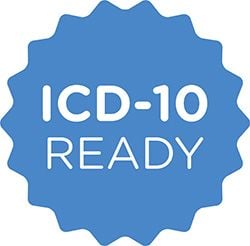Starting on October 1, 2015, one of the largest ICD revisions to date will go into effect for all physicians and other health care providers covered by HIPAA. With thousands of new codes added, the International Classification of Diseases, Tenth Revision, Clinical Modification (ICD-10-CM) will enable physicians to more accurately describe the clinical picture of the patient.
Because of the wide scope of the changes, making the switch to ICD-10-CM will not be an easy undertaking. However, with thorough planning and proper education for your staff, you will be able to make a smoother transition in October, with minimal disruption to your practice.

This information was adapted from a webinar on ICD-10-CM hosted by the American College of Phlebology.
Major Differences Between ICD-9-CM and ICD-10-CM
ICD-10-CM includes several major changes, such as the use of alphanumeric codes and the restructuring of chapters in the manual. The number of chapters has also increased to 21, up from 17 in ICD-9-CM. Separate chapters are provided for the eye and adnexa, and the ear. In addition, certain ICD-9-CM supplemental classifications now have their own chapters.
One of the most noticeable changes in ICD-10-CM is the format and structure of the codes. Previously, ICD-9-CM codes were three to five characters in length. The codes in ICD-10-CM are now alphanumeric and can be up to seven characters long.
Categories in ICD-10-CM are all three characters long, such as I10 for “Essential (primary) hypertension.” Subcategories are either four or five characters long, such as I83.12 for “Varicose veins of left lower extremity with inflammation.” If a category has no subcategories, then the three-character category is equivalent to a code.
Some codes now require a seventh character, which represents the visit encounter or sequelae for injuries and external causes. If the code is four or five characters long, you will be required to use an “X” as a placeholder. For example, W01.0XXA would be used for a “Fall on same level from slipping, tripping and stumbling without subsequent striking against object.” In this case, the character “A” indicates that this was the initial encounter.
The expanded codes also include added laterality for many conditions. For example, the single ICD-9-CM code for “Varicose veins of lower extremities with ulcer” (454.0) has been expanded into several codes in ICD-10-CM, including ones to indicate left and right, as well as the specific part of the lower extremity affected.
ICD-10-CM also references two types of excludes notes. “Excludes1” indicates that the excluded code can never occur with the main code (the two conditions cannot occur together). “Excludes2” is reserved for conditions that are not part of the condition represented by the main code, but ones that may occur in the same patient. In this case, both codes may be used if the patient has both conditions.
To assist in finding the right code to use, the ICD-10-CM manual contains two indexes. The alphabetic index contains terms and their corresponding code. The tabular list contains a chronological list of codes organized into chapters by body system or condition.
Ensuring a Smooth Transition to ICD-10-CM
Using the correct ICD-10-CM codes will not only provide a more accurate clinical picture of the patient but can also reduce the number of claims denied by insurance payers. Some of the key things to keep in mind when coding are:
- Use laterality when appropriate
- Avoid the use of “unspecified codes,” whenever possible
- Include the seventh character, when required (for cause, injury and episode of care)
- Make the full code description visible when using electronic health records
ICD-10-CM now contains more than 68,000 codes, compared to approximately 13,000 codes in ICD-9-CM. In preparation for the transition to ICD-10-CM, insurance payers have had to update all of their rules used to process claims. It is possible that some of these rules may not have been thoroughly tested, which could result in denied or rejected claims.
To minimize the impact of denied claims on your practice, it is important to be systematic about tracking these denials. This includes determining why claims were denied and making corrections. It could be that claims are being denied for not specifying laterality or including the “X” placeholder when required. Communicating frequently with your insurance carrier can also help your staff identify and correct problems earlier.
Adequate training in ICD-10-CM is essential for making the transition as smooth as possible. However, it is not only medical coders who need to be familiar with the ICD-10-CM. Doctors, nurses and other medical staff need to be diligent about including enough specific information in the medical records so that medical coders can choose the correct code, including details such as laterality, cause or injury.
ICD-10-CM represents a major revision. No matter how prepared your hospital or practice is, there will likely be delays in sending claims to insurance carriers. In addition, claims denied due to inaccurate use of codes or problems with the carrier’s claims rules may add further delays. In the end, this can lead to a slow down in your cash flow. Some industry experts suggest that practices — small and large — keep a large enough cash reserve on hand to support them for three to six months.
As with most aspects of medical practice, planning ahead and putting more time into education can ease the transition to ICD-10-CM. Many resources are available online — including the Centers for Medicare and Medicaid Services website — that explain the changes in more detail. These, along with industry-specific training programs can provide you the tools to make October as painless as possible.
Additional ICD-10-CM Resources:


